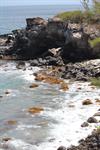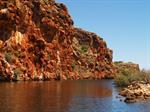
Study Earth Science and learn about the world around you, from stone to sea
Earth Science studies will help you identify
and describe the Earth, its structure and explain processes that affect
change in the structure and composition of the earth. Learn about rocks
and minerals, meteorology, global weather patterns, the oceans, surface
chances (e.g. earthquakes and volcanoes), geological time and more. Useful foundation studies for people interested in:
- Geology and Mining
- Agriculture and Horticulture
- Water and Energy Resource Management
- Environmental Management and Conservation
- Meteorology
Student Comment: "The course was a valuable learning experience. I learned a lot about the Earth's makeup and environmental issues." ~ M Whitehead
Duration: 100 hours
COURSE STRUCTURE AND CONTENT
There are 9 lessons in this course:
- Structure and Forces
- Scope and Nature of the Earth and it's Structure
- Continental and Oceanic Crust
- Continental Drift
- Sea Floor Spreading
- Plate Tectonics
- Plate Boundaries; divergent boundaries, convergent boundaries
- Transform Faults
- Volcanoes; shield volcanoes, cinder cones, composite cones magma, pyroclastic flow
-
 Rocks and Minerals
Rocks and Minerals
- Definitions
- Mineral Properties; crystalline form, luster, colour, streak, hardness, light transmission cleavage, fracture, etc.
- Mineral Groups
- Silicates
- Nonsilicate Minerals
- Rocks; formation, texture
- Sedimentary Rocks; detrital, chemical and biochemical rocks
- Metamorphic Rocks
- Surface Changes
- Introduction
- Weathering
- Mass Wasting
- Erosion
- Glaciers
- Streams; birth of a stream, stream flow, deposited stream sediment
- Ground Water and Land Subsidence
- Aquifers and Confining Beds
- Soil; parent material, time, climate, life forms, slope
- Soil Profile, horizons
- The Oceans
- Scope and Nature of Oceans
- Sea Water
- Currents
- Coriolis Effect
- Geostrophic Flow
- Land Scale Currents
- Convergence and Divergence
- El Nino
- Waves
- Tides
- The Ocean Floor
- Shorelines
- The Marine Food Chain
- Air and Weather
- The Hydrological Cycle
- The Atmosphere
- Atmosphere and Circulation of Essential Elements
- Structure of the Atmosphere, Troposphere, Stratosphere, Mesosphere, Seasons
- Solar Radiation
- The Greenhouse Effect
- Weather
- Temperature Control
- Air Pressure
- Wind; Local Winds, Wind Erosion, Wind in Arid Climates
- Thunderstorms
- Tropical Cyclones
- Tornadoes
- The Greenhouse Effect
- Introduction
- Global Warming
- Anthropomorphic Changes to Global Climates
- Ozone Layer and Ozone Destruction
- Atmospheric Pollutants
- Global Weather Patterns
- Climate
- Climate Classification; Tropics, Dry Climates, Humid Mid Latitude and Mild Climates, Polar Climates, etc
- Geological Time
- Geological Time Scale
- Relative Dating
- Inclusion
- Correlation
- Types of Fossils
- Radiometric Dating; radiocarbon dating, radioactivity, half life
- Geological Time
- Modern Environmental Issues
- Balance of Nature
- Major Current Environmental Events
- Resource Depletion
- Conservation Issues
- Pollution and Waste
Each lesson culminates in an assignment which is submitted to the school, marked by the school's tutors and returned to you with any relevant suggestions, comments, and if necessary, extra reading.

Course Aims
On successful completion of the course you should be able to do the following:
- Describe the major structural elements of Earth and the major internal forces which affect them.
- Classify rocks and minerals according to their characteristics and formation.
- Explain external processes that that cause topographic and soil changes on the earth’s surface.
- Describe the oceans of the earth and their role in global processes.
- Describe the earth’s atmosphere and the forces which create weather.
- Describe some well known effects of particular atmospheric conditions like the Greenhouse effect.
- Identify global weather patterns and their relationship to different climates.
- Describe the way in which the earth’s surface has changed over time.
- Identify environmental issues which are of current significance.
WHAT THE COURSE COVERS
- Research how a mountain/mountain range in or near your region was formed.
- Explain plate tectonics.
- Collect and classify rock samples as either sedimentary rock, igneous rock, or metamorphic rock.
- Describe four ways that weathering breaks down rocks to help form soil.
- Explain how the speed of a stream affects the shape of the landscape.
- Name the three main layers of the ocean, describe the characteristics and ocean life in each.
- Keep a record of atmospheric and weather changes in your environment.
- Explain the highs and lows associated with air pressure, and how they affect weather.
- Create a questionnaire to determine understanding of the Greenhouse Effect or the Ozone layer.
- Explain why your region has its overall climate.
- Research what life forms (plant and animal) inhabited your region before the formation of humans.
- Identify the rules and laws used to date fossils.
- Research an environmental problem in your area, and discuss possible solutions
KNOWING ABOUT THE EARTH REDUCES RISK
When you know and understand the earth, what it is made up of and how it functions, you are able to make "educated guesses" about all sorts of things; from what the weather will be like, to where you are most likely to find certain minerals.
Structure and Forces including plate tectonics and volcanoes Never has it been more timely to understand the world you live in, in Earth Science you will learn about the dynamic forces that have structured the Earth as you see it, you will also learn about the complex interplay of processes such as atmospheric and oceanic forces can have a direct effect upon the climate and the environment. Additionally this covers some of the major environmental issues that we now face such as climate change and atmospheric pollution.

How is Weather Predicted?
These days, forecasting has come a long way since observations and barometric readings were the main sources of information. Nevertheless, all models and techniques become less reliable the further into the future the forecasts are made. That is, as forecast range increases, accuracy decreases. The main approaches to weather forecasting are:
- Synoptic (traditional)
- Numerical weather prediction
- Statistical methods
Often the skill is in choosing which model to use to get the best type of forecast data for what is required, and how to interpret that data to accurately portray its meaning.
Synoptic (Traditional) Forecasting
Synoptic forecasts were the first type of weather prediction technique. Synoptic refers to actual weather measurements at the time of observation. This method of forecasting was the chief method used through to the end of the 1950s.
Meteorological centres prepared a number of synoptic charts on a daily basis to provide an average of the overall changes in weather patterns. This involved collecting and utilising thousands of observations made from weather stations. Over a period of years this data was used to create empirical rules which could be applied to forecasts of changing weather systems.
Back then, little was known about the relationship between upper air conditions and surface weather. These days, that information can be applied to interpretations of charts. Also, they had little insight into why weather systems move at certain times of the year along particular paths so there was no application of scientific formulas and a much greater reliance on the personal skill and knowledge of the forecaster.
Numerical Weather Prediction (NWP)
As the name implies, this method uses numerical calculations. It is based on the knowledge that atmospheric gases are bound by physical laws and principles. NWP is a widely used technique in modern forecasting. Physical laws can be used to determine future atmospheric conditions by applying them to current conditions.
Numerical equations are used to help develop models of atmospheric movements and to predict changes. Formulas exist for a range of atmospheric conditions such as precipitation, air movement, temperature, humidity, and so forth.
In order for numerical predictions to work, the current state of the atmosphere must be known, and this information is provided by radar stations around the planet. Additional satellite data on cloud cover and humidity is also used. This information is used to produce weather maps.
Given the vast number of atmospheric variables most numerical models assume that some will not change on focus only on measuring those that are likely to. They are therefore somewhat approximate but they do have great predictive power. Most are performed using computers given the amount of complex calculations needed.
Forecasts are made for given areas over several days by calculating predicted changes for small time intervals throughout that period.
The main problems with this technique are:
- The limitations of computers (given the amount of numerical calculations needed to make even one prediction)
- One error in data entry magnifies with each calculation
- The equations used are not precise – which leads to some degree of error
- It cannot take account of smaller scale (meso-scale) systems e.g. cyclones which can however impact upon people’s lives
Statistical Methods
These make use of past weather events to predict future weather by assuming that past weather in a given area is a good indication of future weather, and they are often used alongside NWP. Statistical methods involve compiling vast amounts of data about various weather parameters for different areas and regions over many years. From this data they can be used to predict long range guesstimates of future conditions.
BE INFORMED
Take the time to keep yourself informed and study Earth Science at your own home and at your own pace by enrolling in this important course now.
WHAT NEXT?
Register to Study - Go to the panel towards the top right hand-side of this page.
or,
if you have any questions, please get in touch with us today - connect with our specialist tutors - use our FREE COURSE COUNSELLING SERVICE.